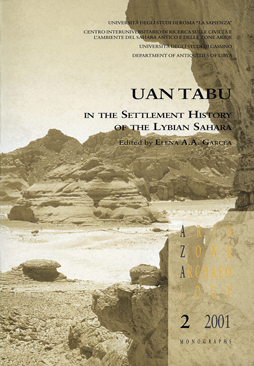 Uan Tabu in the Settlement History of the Libyan Sahara
Uan Tabu in the Settlement History of the Libyan Sahara

Uan Tabu è un riparo sotto roccia situato sulla riva sinistra della valle Centrale dello Wadi Teshuinat, uno degli antichi corsi d’acqua più importanti del massiccio montuoso del Tadrart Acacus. Si trova nella regione del Fezzan, in Libia Sud-Occidentale (Grande Jamahirya). Il sito è stato scoperto da Fabrizio Mori nel 1960 ed è stato riscavato e studiato da un gruppo multidisciplinare all’inizio degli anni ‘90. Esso contiene anche notevoli opere d’arte rupestre appartenenti alle fasi delle Teste Rotonde e Pastorale. Tra il 1960 e il 1963, è stato scavato un sondaggio nel deposito archeologico rinvenuto ai piedi della parete del riparo. I risultati dello scavo degli anni ’60 non sono mai stati pubblicati precedentemente, ad eccezione di alcune brevi notizie. Essi vengono accuratamente descritti e discussi nel presente volume. Tra il 1990 e il 1993, è stato ripreso ed esteso lo scavo, che è stato pubblicato in modo preliminare. Vengono ora presentati e commentati ulteriori informazioni e dettagli. In questo volume viene anche proposta una correlazione stratigrafica e culturale tra i due scavi. Sono state identificate e datate quattro unità archeologiche e pedologiche principali. Esse coprono il periodo compreso tra il tardo Pleistocene e il tardo Olocene. La fase più antica, di età pleistocenica, comprende un complesso ateriano ed è stata datata intorno a 61.000 anni BP. Successivamente, durante l’antico Olocene, è apparsa un’occupazione ‘pre-pastorale’ a partire dal X millennio bp. Questo periodo è stato distinto in due fasi caratterizzate da sistemi socio-culturali diversi: 1. Durante l’Early Acacus (intorno a 9800-8800 anni bp), il sito veniva utilizzato stagionalmente, probabilmente durante la stagione secca, per praticare attività di caccia; 2. Durante il Late Acacus (intorno a 8800-8600 anni bp), si è ipotizzata un’organizzazione più sedentaria per gli abitanti del sito. Queste due facies culturali interessano le tre unità superiori. La quarte fase di occupazione del riparo è solo attestata in superficie, ma può comunque essere considerata un’indicazione dell’uso del sito durante il tardo Olocene, fino al IV millennio bp. Resti di sterco rinvenuti in una fessura della parete del riparo sono stati datati alla fine della fase tardo Pastorale e rappresentano l’unica evidenza della presenza di aniMali domestici.
|
|
Uan Tabu is a rockshelter on the left bank of the central valley of the Wadi Teshuinat, which is a main ancient water course in the Tadrart Acacus mountain range. It is located in the Fezzan region, southwestern Libya (Great Jamahirya). The site was discovered by Fabrizio Mori in 1960 and was re-excavated and studied by a multi-disciplinary team at the beginning of the 1990s. It has also remarkable rock art that includes paintings from the Round Head and Pastoral phases. Between 1960 and 1963, a trench was dug into the archaeological deposit at the foot of the rock wall. The results of the 1960s’ excavation have never been published before, apart from some brief notes. They are thoroughly described and discussed in the present volume. Between 1990 and 1993, the excavation was resumed and extended. The 1990s’ excavation has been preliminarily published. Further information and details are now presented and commented. A stratigraphic and cultural correlation between the two excavations is also attempted in this volume. Four main archaeological and paedological units were identified and dated. They spanned from the Late Pleistocene to the Late Holocene. The earliest one, dating to the Pleistocene, included an Aterian techno-complex and was dated to around 61,000 years BP. Later, during the Early Holocene, a ‘pre-pastoral’ occupation occurred since the 10th millennium bp. This period was differentiated in two phases characterised by different socio-cultural systems: 1. during the Early Acacus (around 9800-8800 years bp), the site was used on a seasonal basis, probably during the dry season, for practising hunting activities; 2. during the Late Acacus (around 8800-8600 years bp), a more sedentary lifestyle was hypothesised for the inhabitants of the site. These two cultural facies comprised the upper three units. The fourth phase of occupation of the shelter was only attested to the surface of the site, but it could be still considered as an indication of the use of the site during the Late Holocene, as late as the 4th millennium bp. A dung fill in the wall of the rockshelter dated to the end of this, Late Pastoral, phase and is the only evidence for domesticated animals. |